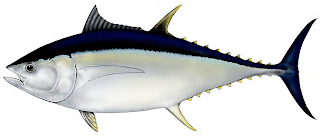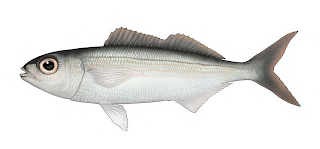The Azores Fisheries Observer Programme was funded in 1998, ensuring the absence of dolphin mortality or injury in tuna fishery. Since then, fishery and fishing products are certified by the Earth Island Institute, through the results presented by POPA. Besides that, tuna fishery is also certified as “Friend of the Sea” (www.friendofthesea.org) which means that it is extremely selective, doesn’t harm the surrounding environment and is quite sustainable. It became the first tuna fishery in the world achieving that certification.
Target species:
Katsuwonus
pelamis / Bonito/ Gaiado 45cm-3Kg
|
Thunnus alalunga/ Voador 1.1m-25kg
(1.3m-40Kg)
|
Thunnus obesus/ Patudo 1m-25Kg (2.4m-200Kg)
|
Thunnus
albacares/ Albacora/ Galha-à-ré 2m-200Kg
|
Juvenis:
Thunnus
albacares/ Galha-à-ré
Thunnus obesus/ Patudo
|
Thunnus thynnus thynnus/Rabilo2m-250Kg (2m-700Kg)
|
Some of the species used by fishermen as live bait for the tuna fishing:
Scomber japonicus/ Cavala
|
Trachurus picturatus/
Chicharro
|
Capros aper/ Peixe-pau
|
Boops boops/ Boga
|
Pagellus bogaraveo/
Carapau,Peixao,Goraz
|
Macroramphosus scolopax/
Trombetei
|
The Dolphin Safe concept http://www.horta.uac.pt/projectos/popa/index_PT.html
In
the Eastern Tropical Pacific occurs an association between dolphins and
yellow fin tunas: the fishes swim beneath the dolphins. During the 1950’s,
tuna trawlers started to take advantage of this fact: they looked for
dolphins at the surface and then, positioned the nets all around them,
capturing every animal within that area. In consequence, this technique
was responsible for a vast mortality of dolphins that reached 120000
individuals per year during the 1980’s. Those species became increasingly
endangered, and several NGOs (eg: Earth
Island Institute, USA) and consumer
associations started to pressure the tuna industry and the government
of the USA to change this reality. Those actions led to the “Dolphin
safe” concept and logo which only applies to fisheries that do
not harm or kill dolphins. Since that time, commercialization of non
certified tuna is prohibited in the US. In order to monitor those fisheries,
observervation programmes were initiated and through them it became possible
to collect in situ data regarding interactions between cetaceans and
fisheries as well as other important scientific records. From 1992 on,
dolphin mortality started to decrease (it reached a maximum of 4000 individuals
per year) which proved the efficiency of referred measures.
In the late 1990’s, it became clear that tuna industry would be
seriously penalized with the absence of a “Dolphin safe” certification
which instigated new measures from the government and the fisheries sector. In order to achieve this certification, the Azores Fisheries Observer Programme was funded in
1998, ensuring the absence of dolphin mortality or injury
in tuna fishery. Since then, fishery and fishing products
are certified by the
Earth Island Institute, through the results presented
by POPA. Besides that, tuna fishery is also certified
as “Friend
of the Sea” (www.friendofthesea.org)
which means that it is extremely selective, doesn’t
harm the surrounding environment and is quite sustainable.
It became the first tuna fishery in the world achieving
that certification.
The Programme results from an agreement between Regional Administration,
Earth Island Institute, the Tuna Canning Industry Association (Pão do
Mar), the Fishing Boat Owners Association (APASA) and IMAR – Instituto
do Mar - through the University of The Azores Center (IMAR-DOP/UAç),
which carries out the programme. Until 2003 the Programme was supported
by regional funds. Between 2003 and 2005 it became co-financed by the
European Commission through the INTERREG IIIb Programme/ ORPAM project.
Since then it has been exclusively supported by the regional government
through the Regional Secretary of Fisheries.
Other institutions related to fisheries:
http://www.iccat.int/en/links.htm
- TUNA-ORG: A joint website for Tuna RFMOs
- UNFSA Fund: A fund created under the UN Fish Stocks Agreement to provide assistance
- ASFA access to LIFDC: Project to supply the ASFA database (free of charge) to low income food deficit countries
- FIRMS: Fishery Resources Monitoring System
Tuna Regional Fishery Management Organizations
- CCSBT: Commission for the Conservation of Southern Bluefin Tuna
- IATTC: Inter-American Tropical Tuna Commission
- IOTC: Indian Ocean Tuna Commission
- WCPFC: Western and Central Pacific Fisheries Commission
Fishery Research and Management Organizations (National and International)
- SPC-OFP: Secretariat of the Pacific Community (Oceanic Fisheries Programme)
- FFA: Pacific Islands Forum Fisheries Agency
- CCAMLR: Commission for the Conservation of Antarctic Marine Living Resources
- CIESM: Commission Internationale pour l´Exploration Scientifique de la mer Méditerranée
- FAO: Food and Agriculture Organization
- GFCM: General Fisheries Commission of the Mediterranean
- GLFC: Great Lakes Fishery Commission
- ICES: International Council for the Exploration of the Seas
- IPHC: International Pacific Halibut Commission
- ISC: International Scientific Committee for tuna and tuna-like species in the North Pacific Ocean
- IWC: International Whaling Commission
- NAFO: Northwest Atlantic Fisheries Organization
- NAMMCO: North Atlantic Marine Mammal Commission
- NASCO: North Atlantic Salmon Conservation Organization
- NEAFC: North-East Atlantic Fisheries Commission
- NPAFC: North Pacific Anadromous Fish Commission
- PICES: North Pacific Marine Science Organization
- PSC: Pacific Salmon Commission
Various Offices and Laboratories in Contracting Parties and Cooperating Entities
- CRODT: Centre de Recherches Oceanographiques Dakar-Thiaroye, Senegal.
- CRO: Centre de Recherches Océanologiques, Côte-d'Ivoire
- DFO: Department of Fisheries and Oceans (Canada).
- IBAMA: Instituto Brasileiro do Meio Ambient e dos Recursos Naturais Renovaveis (Brazil).
- IEO: Instituto Español de Oceanografia (Spain).
- IFREMER: Institut Français de Recherche pour lÉxploitation de la Mer (France).
- IRD: Institut de Recherche pour le Developpement (France).
- DEFRA: Dept. Environment, Food and Rural Affairs (United Kingdom).
- CEFAS: Centre for Env., Fish. and Aquaculture Sciences (United Kingdom)
- NRIFSF: National Research Institute of Far Seas Fisheries (Japan).
- NMFS: National Marine Fisheries Service (U.S.A.).
- AZTI: Inst. Tecnologico Pesquero y Alimentario (Spain)
- MFMR: Ministry of Fisheries and Marine Resources (Namibia)
- NFRDA: National Fisheries Res. and Development Institute (Korea)
- INAPE: Instituto Nacional de Pesca (Uruguay)
- MARE: Europpean Commission - Directorate-General for Maritime AffairsFisheries (EC)
- MPM: Ministère des Pêches Maritimes (Maroc)
- DEAT: Dept. Environmental Affairs and Tourism (South Africa)
- IZOR: Institute of Oceanography and Fisheries (Croatia)
- VNIRO: Russian Federal Research Inst. of Fishery Oceanography
- EUROSTAT: Statistical Offices of the European Communities (EC)
- INIAP: Instituto Nacional de Investigação Agrária e das Pescas (Portugal)
- INIA: Instituto Nacional de Investigaciones Agricols (Venezuela)
- HCMR: Helenic Centre for Marine Research (Greece)
- UAC: Universidade dos Açores (Portugal)
- NTU: National Taiwan University (Chinese Taipei)
- UNIBA: Universita degli Studi di Bari (Italy)
- UNICA: Universita degli Studi di Cagliari (Italy)
- U. of Hawaii Pelagic Fisheries Research Program
- NMFS/Monterey Bay Aquarium/Stanford U. Bluefin Tagging Project
- Bluefin Tuna in Scandinavian Waters
- University of New Hampshire Large Pelagics Research Lab
- US Food and Drug Administration Center for Food Safety and Applied Nutrition
- NMFS Resource Ecology and Fisheries Management (Alaska)
- Fishbase (ICLARM)
- Fish Ecology List Server Archives
- CSIRO Fisheries
- U. Washington Statistics Dept.
- Norway College of Fisheries
- FAO Atlas of Tuna and Billfish Catches
- ASFIS taxonomic list of species and statistics codes
- Concerted Action for Tagging of Fishes (EU project)
- European Centre for Information on Marine Science and Technology
- Fisheries wiki














No comments:
Post a Comment